#robert singer icons
Explore tagged Tumblr posts
Text









- 𝘳𝘢𝘯𝘥𝘰𝘮 𝘪𝘤𝘰𝘯𝘴 ★
#icons#icons random#random icons#icons without psd#icons actress#actress icons#twitter icons#singers icons#bjork#julia roberts#sophie tatcher#chiaki kuriyama#caitriona balfe#anna de armas#jung hoyeon#shelley duvall#lea seydoux
91 notes
·
View notes
Text












nicola roberts.
#nicola roberts icons#nicola roberts#girls aloud icons#girls aloud#girls icons#singer icons#icons#icons sem psd#icons without psd#coral#twitter icons#bluesky icons
24 notes
·
View notes
Text









nicola roberts like/reblog 🌟
#nicola roberts icons#nicola roberts#icons nicola roberts#girls aloud#girls aloud icons#british#singer#icons#girls icons#female icons#sem psd#twitter icons#without psd
41 notes
·
View notes
Text

Barbra Streisand and Robert Redford🍀🌱🍀
Via BARBRA STREISAND FB🌱
#60s icons#girlsofthesixties#barbra streisand#singer#great voice#robert redford#movie stars#hollywood stars
15 notes
·
View notes
Text

Robert Smith and kitty from „Lovecats” - The Cure
#80s goth#the cure#robert smith#gothic#post punk#goth#pop#kitty#kitty cat#lovecats#music video#singer#vocalist#iconic
38 notes
·
View notes
Text

Robert Plant - Led Zeppelin
#music#robert plant#led zeppelin#icon#legend#vintage#retro#band#musician#singer#songwriter#fashion blogger#style blogger#beauty blogger
3 notes
·
View notes
Text
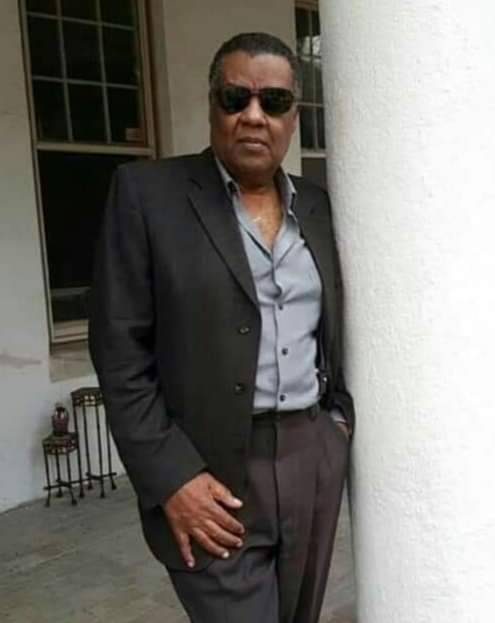
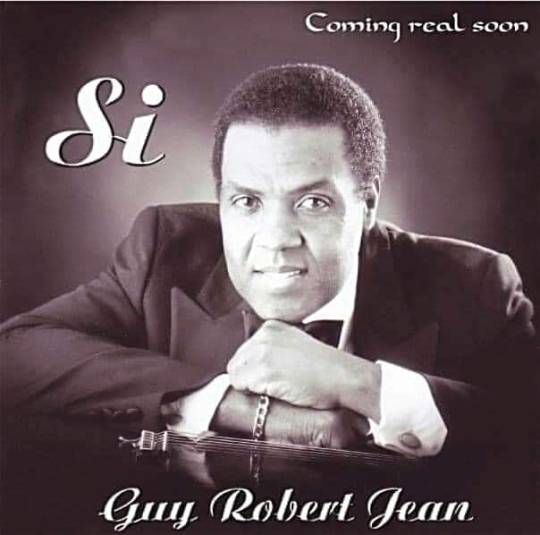

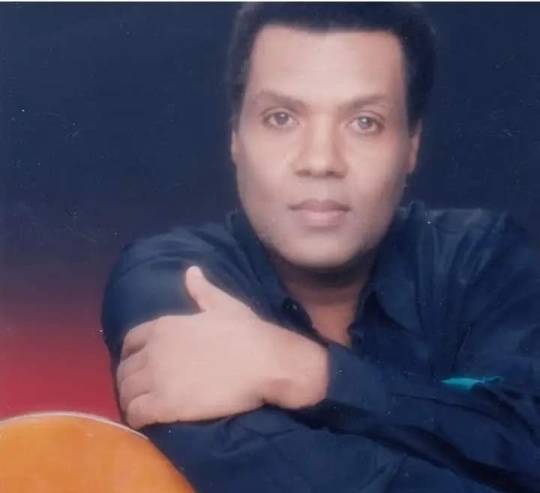
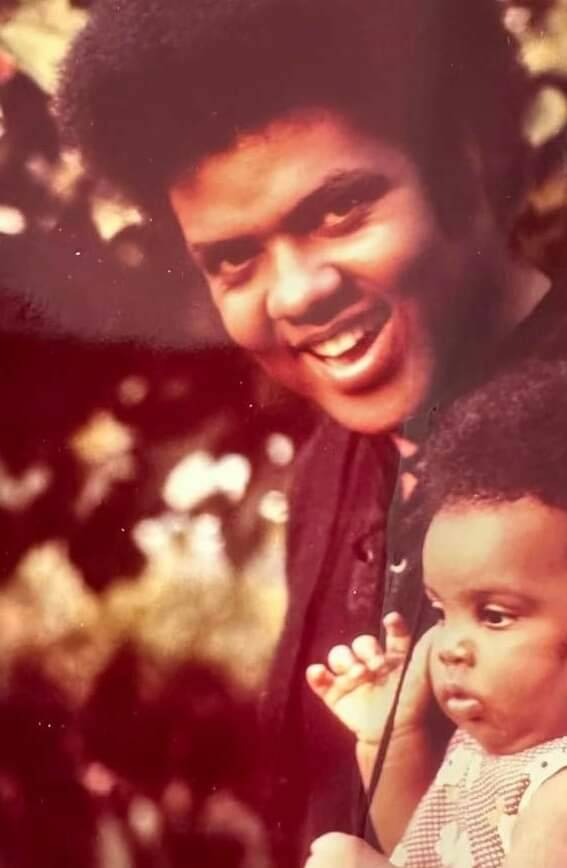

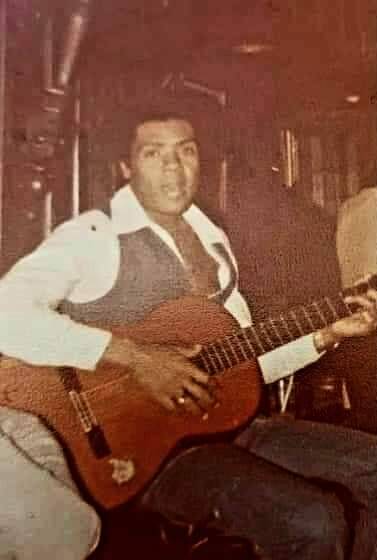
GUY ROBERT JEAN, Entertainer, guitarist and singer-songwriter (R.I.P)
We extend our deepest condolences to his family and friends during this difficult time. His music was a true testament to his talent and passion for the art. May he rest in peace and his legacy continue to inspire others.
#Haitilegends
_________
By Natalie Jean
"When you are a kid, you believe that your parents will live forever. You bask in that joy. Doesn't even dawn on you, that one day they too shall pass. He used to sing the Haitian anthem to wake me up to go to school. He would often grab his guitar and we would sing our favorite songs. As you grow older, you realize that time is a precious thing and that you should make sure that the ones you love, know that you love them. I never imagined the amount of pain that I would feel at losing my father. I knew that I would be sad, that's a given. I am in pain and numb at the same time. It is really indescribable. On April 4, 2023, my father lost his battle with prostate cancer. He fought the good fight. He started as a man that I knew and he became a man that I had already recognized. My father took me to my first concert...Air Supply😱😱😱...yes, I am dating myself. Then he took my cousin Kathia and I to see New Edition. Our last concert was Jack Wagner from General Hospital🤦🏾♀️...I liked him at the time. Our relationship wasn't perfect during the teenage years. But we grew to understand one another along the way. my father is a well known Haitian Singer. He was an amazing singer, songwriter, and musician. He gave me my voice, which I will always be grateful for. He wrote some of the songs on my French and Haitian album. We even won an award together. We were on the same music charts. It is hard to watch someone you love in so much pain. My mother, Marie Louise Jean, sister Danielle Jean, and stepmother Katty Jean were at his side at home and at the hospital (which was frequent) as much as possible. While in the hospital, we slept on the chairs, by his side, and even on the floor. I am glad that he is at peace now. But I won't lie and say that I wish he were still here. When someone sees me, they always tell me how much I look like my father. While I love the idea, it makes me sad...because when I look in the mirror...I see him. I am not doing well...but I am trying to cope with this loss as best as possible. I love you Guy Robert Jean 🤗❤️😭. May you rest in peace. Until we meet again😭"
________
By Sandra Jean
My loving brother
Though I know you don t like all this, but how can I let you go without talking you into the light. Just tap into it, it will fill you and guide you to your destination. Mom , dad, our brother Max and the rest of the elders already there waiting for you. You have left us in pain, but we know that you are now in the moment of truth and in a better place. I know you are an angel watching over us, while we continue our journey. We will always. Love you.😭😭😭😭😭
_________
📀 Youtube :
Guy Robert Jean
https://youtube.com/channel/UCTRDFOjKnhWPzePUFfpk-aw
_______________
🔊🎶 "Recuerdame (En Vivo)" on YouTube
https://youtu.be/j9aUAl3tPFw
__________________
#👈🏾
#GuyRobertJean
#GRJProductions
#PortdePaix (hometown)
#entertainer
#HaitianSinger
#SingerSongwriter
#composer
#FrenchSongs
#SpanishSongs
#Ballads
#romantic
#haitianmusic
#bolero
#lovesongs
#guitar
#haitianmusicians
#guitarist
#guitariste
#Hommage
#homage
#tribute
#RestinPeace
#LaDessalinienne
#HaitianNationalAnthem
#NatalieJean
#SandraJean
#guy robert jean#haiti legends icons#haitilegends#restinpeace#entertainers#musician#haitian singers#haiti legends
0 notes
Text




Bob Marley also known as Robert Nesta Marley, born on February 6, 1945, in Nine Mile, Saint Ann Parish, Jamaica, was a singer, songwriter, and global cultural ambassador who transformed reggae into a powerful platform for change. As the lead vocalist of The Wailers and later a solo artist, Marley’s music transcended boundaries, with timeless hits like "No Woman, No Cry," "Redemption Song," and "Buffalo Soldier." His lyrics championed themes of love, justice, spirituality, and resistance against oppression, making him a voice for the downtrodden and a symbol of hope worldwide.
Through his Rastafari faith, Marley fused his music with messages of peace, anti-colonialism, and African identity. Deeply inspired by figures like Marcus Garvey and Haile Selassie I, Marley advocated for Pan-Africanism—the unification and empowerment of African-descended peoples. His song "Africa Unite" remains a rallying cry for solidarity, while "Zimbabwe" became an anthem for the country’s independence. Marley’s connection to the global fight for liberation cemented his legacy as more than a musician; he was a revolutionary figure in the struggle for equality.
Tragically, Marley passed away on May 11, 1981, at just 36 years old. He succumbed to melanoma, an aggressive skin cancer that began under his toenail and spread to his brain and lungs. Despite his diagnosis, Marley continued performing until his health made it impossible. His final words to his son Ziggy were: “Money can’t buy life.”
Bob Marley’s influence extends far beyond music. His ability to articulate the struggles and hopes of the African diaspora, while inspiring millions to seek unity and freedom, makes him one of the most enduring cultural icons of all time. 🇯🇲
#black people#black history#black#black tumblr#blacktumblr#pan africanism#black conscious#africa#black power#black empowering#bob marley#jah rastafari#rastafari#rasta#reggae legend
115 notes
·
View notes
Text
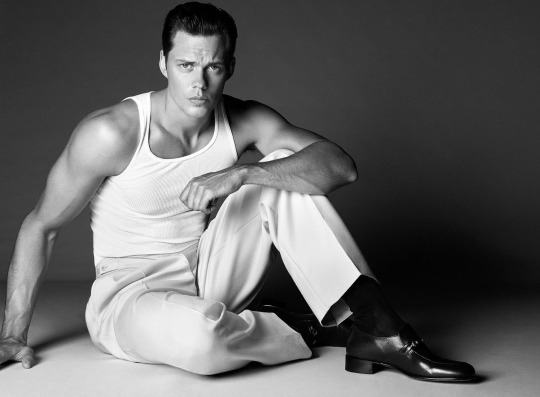
Bill Skarsgård on Remaking Nosferatu and the Pressure of “F--king With a Masterpiece”
The actor on Pennywise, Count Orlok, and the lure of monstrous characters.
(for those who weren’t able to read the article due to a paywall the full interview is now under the cut)
“I’ve always been a very happy monster.” So said Boris Karloff in 1962, looking back at three decades of creatures, ghouls, and killers that defined so much of his life onscreen. Bill Skarsgård hasn’t been at it nearly as long, but his tendency to play supernatural and terrifying figures suggests that, like his fiendish predecessor, he’s made peace with monstrosity.
The blockbusters It and It: Chapter 2 made him a horror icon as Pennywise the Dancing Clown, carrying on a long tradition in his Swedish acting family—which includes his father, Stellan, and older brothers Alexander and Gustaf—of playing haunting roles in hair-raising films. Since Pennywise, Bill has specialized in sinister, scene-stealing parts, from a high-society sociopath in John Wick: Chapter 4 to his recent turn as the otherworldly avenger of this year’s reboot of The Crow. His latest turn finds him playing the vampiric title character in Nosferatu, from The Witch and The Lighthouse filmmaker Robert Eggers, in a collaboration that brings an ominous new approach to the bat-faced antagonist of the 1922 silent film.
For Vanity Fair’s 2025 Hollywood Issue, he talked about touching the void and more.
Vanity Fair: We spoke years ago when you were about to start filming It, and you talked about the challenges of inhabiting an inhuman monster.
Bill Skarsgård: That was the first time—and wouldn’t be the last time—that I was taking on this kind of iconic character that has been done before so well, and that people love and cherish. The whole journey of that was so weird. If I spoke to you after the production, I would’ve been much more confident that we had something that was very special, but in the process of it, I was just like, Why did he cast me? I can’t do this.
We did speak again afterward. You talked about going home to your parents’ house after you finished shooting and being plagued by dreams about the character.
Those dreams were so strange. Either I was confronting Pennywise and I was upset with him, yelling at him—or I was Pennywise, but I was walking around in the streets that I grew up on, and I’m like, No, no. I shouldn’t be out here in public walking around like this. This is not how it’s supposed to be done. It was this weird thing where I was trying to separate myself from this thing, literally back in the place that I grew up in, in the same apartment that I grew up in.
Count Orlok in Nosferatu also emerges from a deep, dark place. What was it like for you to take that particular emotional ice bath?
Count Orlok was very different than Pennywise in a lot of ways. Orlok was even further away from who I am than Pennywise was, in the sense that my voice, posture, age, the look of it, it was just so far out there. That became the challenge. Before putting on the prosthetics, we explored so many weird things and looked into butoh, this sort of Japanese corpse dancing. We explored so many trippy things.
Did you say “corpse dancing”?
Yeah, butoh is this Japanese corpse dance. It’s all these, kind of, mummified movement patterns. It’s spectacular. It brought this much more precise and much more rigid and slow movement. Basically the outfit and the prosthetics helped so much. The voice was what I worked the hardest on. I worked with an opera singer—she tried to get it as low as possible. My brother Gustaf came to set when we were shooting. He’s sitting there and he gets the headphones on and he hears [deep growling sounds] and is like, “What the fuck is going on?” It must have seemed very insane.
Since you come from an acting family, I wondered what role your dad and your brothers play in your decision-making process or in your professional life.
I don’t talk to them in the sense of like, “Hey, do you think I should do this thing or that thing?” Of course, subconsciously, they’re such a big part of my life. It’s hard to quantify how much effect they’ve had in terms of my taste or in terms of performances. It’s great to have their support, more so in life in general than acting itself. It’s nice to be able to talk to your family, just going, like, “Oh, this shoot was a nightmare because of this and this and this.” And they’re like, “Oh yeah, totally. Tell me about it.” The job, the profession of acting, can feel kind of lonely sometimes. It just feels nice to have so many people, close people, around you that truly know what it’s like.
Especially after Nosferatu, people are going to look at your work and see a lot of monsters and a lot of dark figures. Why do you think you’ve been drawn to these characters?
I think those characters are drawn to me as much as I’m drawn to them. It’s a mutual kind of attraction. The fact that they’re drawn towards me is a bunch of different reasons, everything from the way you look, you have a sensibility, there’s a darkness about you, or there’s an intensity.
And it’s something you enjoy too?
Even going back to some of the earlier stuff I did in Sweden, transformation has always been very appealing to me—and playing characters that are very different than me. I played a character that was autistic when I was 19, and I loved it. I had so much joy in it. He’s not a dark character, he’s a very sweet character. But you study, and you change your voice. With Pennywise, that became my ultimate transformation. I just really enjoyed it. Now with Orlok, I really enjoy transforming as much as I humanly can. I think that’s very exciting.
Do you feel a curiosity about the more dangerous side of human nature?
The darker characters also tend to be more complex. More mental gymnastics are needed. Again, with Orlok, it’s like, Okay, if it’s an ancient sorcerer that speaks from a different realm and possesses all of this power and knowledge, what makes power and knowledge ultimately corrupt a soul as opposed to creating a messiah?
Do you ever worry about getting typecast?
I definitely don’t want to exclusively play those kind of roles, but I’ve never seen the appeal of the classic star, a movie star. The difference between a movie star and an actor is that a movie star plays himself in every part, in a way. Whereas as an actor transforms. There are people that play themselves, and they’re brilliant every single time, but it’s the same thing and they have that shtick. For me, I just don’t think that I’m that charismatic or interesting, so I can’t just lean on that. I need to transform as far away from me as possible.
Do you feel a kinship with actors from the past, like, say, Lon Chaney or Boris Karloff, who played dark beings and often transformed their regular appearances?
It’s a great question. Yeah, I do. But that being said, it was never my particular goal to be the “creature actor,” if you will. There are so many [actors] I draw inspiration from. A lot of other actors that are not known for their intense transformations are some of my favorites as well. I haven’t really studied the greats of prosthetics or creature performances in that way. I’ve watched a lot of it, but I don’t watch performances for inspiration per se, because there’s always this thing of emulation that I don’t want to go down. For Orlok, predatory animals felt like a cleaner source of inspiration.
You mentioned earlier that, several times now, you’ve played a character that is well-known from a previous iteration, but you did it in a new and different way. Did you feel that again with Nosferatu?
Orlok is also Dracula. To me, in terms of iconic horror characters, the number one is Dracula/Nosferatu. It’s the most seminal work of literature in gothic horror for sure. I think it’s been adapted more than probably any other book. This story is so ingrained in our subconscious that it was very daunting to step into it. I was a huge fan of [Robert] Eggers before. He and I would have these things we’re like, “What are we doing? Why are we doing Nosferatu? Are we taking on something too big here?” We felt that kind of pressure of fucking with a masterpiece. But the movie deserves its place as a new interpretation.
What’s on the horizon for you next?
I’ve always cherished the idea of being as versatile as I possibly can. I also want to do a kitchen-sink drama, I want to do a dark, fucked-up comedy. I want to make those choices or advocate for those choices. You have to fight against being typecast or put into a box. The more you fight against it, the bigger the box tends to get.
75 notes
·
View notes
Text
Couch surfer in his 30s. Oscar winner in his 40s. Why the whole world wants Taika
**Notes: This is very long post!**
Good Weekend
In his 30s, he was sleeping on couches. By his 40s, he’d directed a Kiwi classic, taken a Marvel movie to billion-dollar success, and won an Oscar. Meet Taika Waititi, king of the oddball – and one of New Zealand’s most original creative exports.
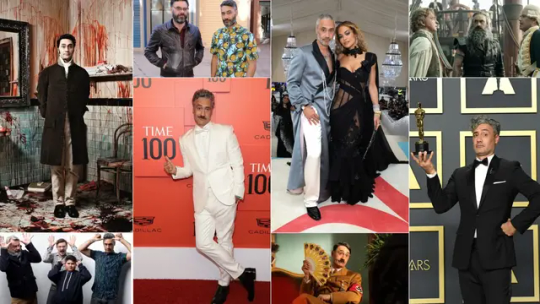
Taika Waititi: “Be a nice person and live a good life. And just don’t be an arsehole.”
The good news? Taika Waititi is still alive. I wasn’t sure. The screen we were speaking through jolted savagely a few minutes ago, with a cacophonous bang and a confused yelp, then radio silence. Now the Kiwi filmmaker is back, grinning like a loon: “I just broke the f---ing table, bro!”
Come again? “I just smashed this f---ing table and glass flew everywhere. It’s one of those old annoying colonial tables. It goes like this – see that?” Waititi says, holding up a folding furniture leg. “I hit the mechanism and it wasn’t locked. Anyway …”
I’m glad he’s fine. The stuff he’s been saying from his London hotel room could incur biblical wrath. We’re talking about his latest project, Next Goal Wins, a movie about the American Samoa soccer team’s quest to score a solitary goal, 10 years after suffering the worst loss in the game’s international history – a 31-0 ignominy to Australia – but our chat strays into spirituality, then faith, then religion.
“I don’t personally believe in a big guy sitting on a cloud judging everyone, but that’s just me,” Waititi says, deadpan. “Because I’m a grown-up.”
This is the way his interview answers often unfold. Waititi addresses your topic – dogma turns good people bad, he says, yet belief itself is worth lauding – but bookends every response with a conspiratorial nudge, wink, joke or poke. “Regardless of whether it’s some guy living on a cloud, or some other deity that you’ve made up – and they’re all made up – the message across the board is the same, and it’s important: Be a nice person, and live a good life. And just don’t be an arsehole!”
Not being an arsehole seems to have served Waititi, 48, well. Once a national treasure and indie darling (through the quirky tenderness of his breakout New Zealand films Boy in 2010 and Hunt for the Wilderpeople in 2016), Waititi then became a star of both the global box office (through his 2017 entry into the Marvel Universe, Thor: Ragnarok, which grossed more than $1.3 billion worldwide) and then the Academy Awards (winning the 2020 best adapted screenplay Oscar for his subversive Holocaust dramedy JoJo Rabbit, in which he played an imaginary Hitler).
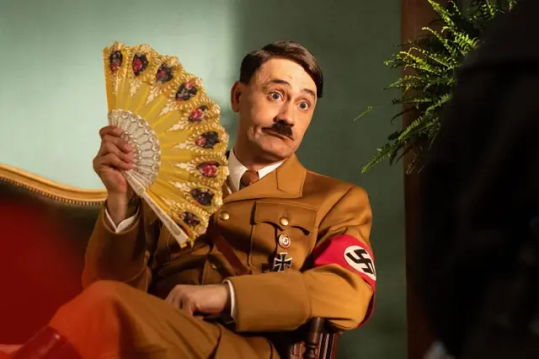
Waititi playing Adolf Hitler in the 2019 movie JoJo Rabbit. (Alamy)
A handsome devil with undeniable roguish charm, Waititi also slid seamlessly into style-icon status (attending this year’s Met Gala shirtless, in a floor-length gunmetal-grey Atelier Prabal Gurung wrap coat, with pendulous pearl necklaces), as well as becoming his own brand (releasing an eponymous line of canned coffee drinks) and bona fide Hollywood A-lister (he was introduced to his second wife, British singer Rita Ora, by actor Robert Pattinson at a barbecue).
Putting that platform to use, Waititi is an Indigenous pioneer and mentor, too, co-creating the critically acclaimed TV series Reservation Dogs, while co-founding the Piki Films production company, committed to promoting the next generation of storytellers – a mission that might sound all weighty and worthy, yet Waititi’s new wave of First Nations work is never earnest, always mixing hurt with heart and howling humour.
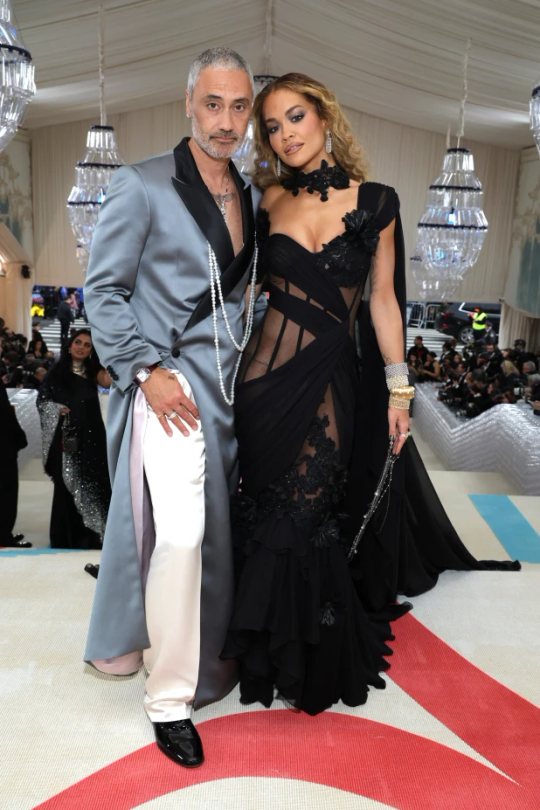
Waititi with wife Rita Ora at the 2023 Met Gala in May. (Getty Images)
Makes sense. Waititi is a byproduct of “the weirdest coupling ever” – his late Maori father from the Te Whanau-a-Apanui tribe was an artist, farmer and “Satan’s Slaves” bikie gang founder, while his Wellington schoolteacher mum descended from Russian Jews, although he’s not devout about her faith. (“No, I don’t practise,” he confirms. “I’m just good at everything, straight away.”)
He’s remained loyally tethered to his origin story, too – and to a cadre of creative Kiwi mates, including actors Jemaine Clement and Rhys Darby – never forgetting that not long before the actor/writer/producer/director was an industry maven, he was a penniless painter/photographer/ musician/comedian.
With no set title and no fixed address, he’s seemingly happy to be everything, everywhere (to everyone) all at once. “‘The universe’ is bandied around a lot these days, but I do believe in the kind of connective tissue of the universe, and the energy that – scientifically – we are made up of a bunch of atoms that are bouncing around off each other, and some of the atoms are just squished together a bit tighter than others,” he says, smiling. “We’re all made of the same stardust, and that’s pretty special.”
-----------------------------------------------
We’ve caught Waititi in a somewhat relaxed moment, right before the screen actors’ and media artists’ strike ends. He’s sensitive to the struggle but doesn’t deny enjoying the break. “I spent a lot of time thinking about writing, and not writing, and having a nice holiday,” he tells Good Weekend. “Honestly, it was a good chance just to recombobulate.”
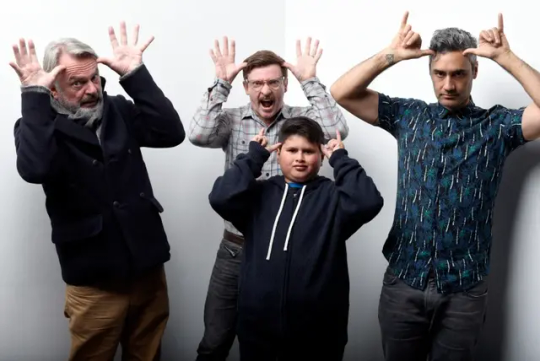
Waititi, at right, with Hunt for the Wilderpeople actors, from left, Sam Neill, Rhys Darby and Julian Dennison. (Getty Images)
It’s mid-October, and he’s just headed to Paris to watch his beloved All Blacks in the Rugby World Cup. He’s deeply obsessed with the game, and sport in general. “Humans spend all of our time knowing what’s going to happen with our day. There’s no surprises any more. We’ve become quite stagnant. And I think that’s why people love sport, because of the air of unpredictability,” he says. “It’s the last great arena entertainment.”
The main filmic touchstone for Next Goal Wins (which premieres in Australian cinemas on New Year’s Day) would be Cool Runnings (1993), the unlikely true story of a Jamaican bobsled team, but Waititi also draws from genre classics such as Any Given Sunday and Rocky, sampling trusted tropes like the musical training montage. (His best one is set to Everybody Wants to Rule the World by Tears for Fears.)
Filming in Hawaii was an uplifting experience for the self-described Polynesian Jew. “It wasn’t about death, or people being cruel to each other. Thematically, it was this simple idea, of getting a small win, and winning the game wasn’t even their goal – their goal was to get a goal,” he says. “It was a really sweet backbone.”
Waititi understands this because, growing up, he was as much an athlete as a nerd, fooling around with softball and soccer before discovering rugby league, then union. “There’s something about doing exercise when you don’t know you’re doing exercise,” he enthuses. “It’s all about the fun of throwing a ball around and trying to achieve something together.” (Whenever Waititi is in Auckland he joins his mates in a long-running weekend game of touch rugby. “And then throughout the week I work out every day. Obviously. I mean, look at me.”)
Auckland is where his kids live, too, so he spends as much time there as possible. Waititi met his first wife, producer Chelsea Winstanley, on the set of Boy in 2010, and they had two daughters, Matewa Kiritapu, 8, and his firstborn, Te Kainga O’Te Hinekahu, 11. (The latter is a derivative of his grandmother’s name, but he jokes with American friends that it means “Resurrection of Tupac” or “Mazda RX7″) Waititi and Winstanley split in about 2018, and he married the pop star Ora in 2022.
He offers a novel method for balancing work with parenthood … “Look, you just abandon them, and know that the experience will make them harder individuals later on in life. And it’s their problem,” he says. “I’m going to give them all of the things that they need, and I’m going to leave behind a decent bank account for their therapy, and they will be just like me, and the cycle will continue.”
Jokes aside – I think he’s joking – school holidays are always his, and he brings the girls onto the set of every movie he makes. “They know enough not to get in the way or touch anything that looks like it could kill you, and they know to be respectful and quiet when they need to. But they’re just very comfortable around filmmakers, which I’m really happy about, because eventually I hope they will get into the industry. One more year,” he laughs, “then they can leave school and come work for Dad.”
Theirs is certainly a different childhood than his. Growing up, he was a product of two worlds. His given names, for instance, were based on his appearance at birth: “Taika David” if he looked Maori (after his Maori grandfather) and “David Taika” if he looked Pakeha (after his white grandfather). His parents split when he was five, so he bounced between his dad’s place in Waihau Bay, where he went by the surname Waititi, and his mum, eight hours drive away in Wellington, where he went by Cohen (the last name on his birth ��certificate and passport).
Waititi was precocious, even charismatic. His mother Robin once told Radio New Zealand that people always wanted to know him, even as an infant: “I’d be on a bus with him, and he was that kind of baby who smiled at people, and next thing you know they’re saying, ‘Can I hold your baby?’ He’s always been a charmer to the public eye.”
He describes himself as a cool, sporty, good-looking nerd, raised on whatever pop culture screened on the two TV channels New Zealand offered in the early 1980s, from M*A*S*H and Taxi to Eddie Murphy and Michael Jackson. He was well-read, too. When punished by his mum, he would likely be forced to analyse a set of William Blake poems.
He puts on a whimpering voice to describe their finances – “We didn’t have much monneeey” – explaining how his mum spent her days in the classroom but also worked in pubs, where he would sit sipping a raspberry lemonade, doodling drawings and writing stories. She took in ironing and cleaned houses; he would help out, learning valuable lessons he imparts to his kids. “And to random people who come to my house,” he says. “I’ll say, ‘Here’s a novel idea, wash this dish,’ but people don’t know how to do anything these days.”
“Every single character I’ve ever written has been based on someone I’ve known or met or a story I’ve stolen from someone.” - Taika Waititi
He loved entertaining others, clearly, but also himself, recording little improvised radio plays on a tape deck – his own offbeat versions of ET and Indiana Jones and Star Wars. “Great free stuff where you don’t have any idea what the story is as you’re doing it,” he says. “You’re just sort of making it up and enjoying the freedom of playing god in this world where you can make people and characters do whatever you want.”
His other sphere of influence lay in Raukokore, the tiny town where his father lived. Although Boy is not autobiographical, it’s deeply personal insofar as it’s filmed in the house where he grew up, and where he lived a life similar to that portrayed in the story, surrounded by his recurring archetypes: warm grandmothers and worldly kids; staunch, stoic mums; and silly, stunted men. “Every single character I’ve ever written has been based on someone I’ve known or met,” he says, “or a story I’ve stolen from someone.”
He grew to love drawing and painting, obsessed early on with reproducing the Sistine Chapel. During a 2011 TED Talk on creativity, Waititi describes his odd subject matter, from swastikas and fawns to a picture of an old lady going for a walk … upon a sword … with Robocop. “My father was an outsider artist, even though he wouldn’t know what that meant,” Waititi told the audience in Doha. “I love the naive. I love people who can see things through an innocent viewpoint. It’s inspiring.”
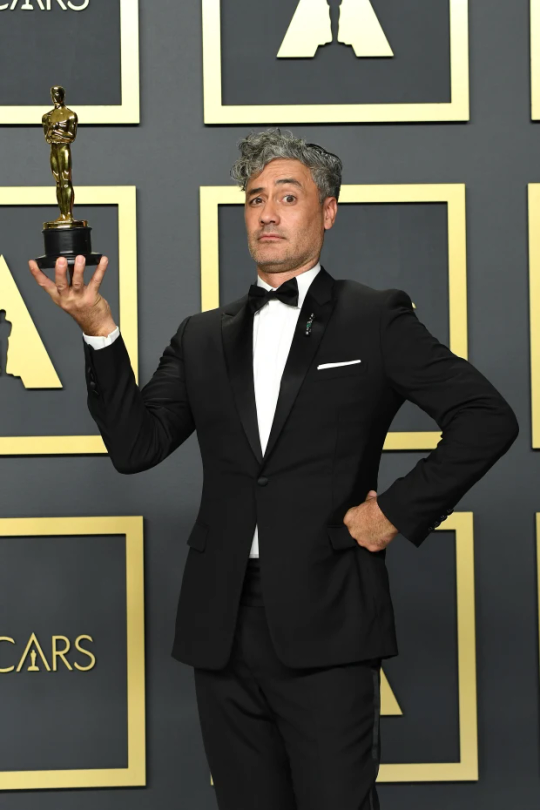
After winning Best Adapted Screenplay Academy Award for JoJo Rabbit in 2020. (Getty Images)
It was an interesting time in New Zealand, too – a coming-of-age decade in which the Maori were rediscovering their culture. His area was poor, “but only financially,” he says. “It’s very rich in terms of the people and the culture.” He learned kapa haka – the songs, dances and chants performed by competing tribes at cultural events, or to honour people at funerals and graduations – weddings, parties, anything. “Man, any excuse,” he explains. “A big part of doing them is to uplift your spirits.”
Photography was a passion, so I ask what he shot. “Just my penis. I sent them to people, but we didn’t have phones, so I would print them out, post them. One of the first dick pics,” he says. Actually, his lens was trained on regular people. He watches us still – in airports, restaurants. “Other times late at night, from a tree. Whatever it takes to get the story. You know that.”
He went to the Wellington state school Onslow College and did plays like Androcles and the Lion, A Midsummer Night’s Dream and The Crucible. His crew of arty students eventually ended up on stage at Bats Theatre in the city, where they would perform haphazard comedy shows for years.
“Taika was always rebellious and wild in his comedy, which I loved,” says his high school mate Jackie van Beek, who became a longtime collaborator, including working with Waititi on a Tourism New Zealand campaign this year. “I remember he went through a phase of turning up in bars around town wearing wigs, and you’d try and sit down and have a drink with him but he’d be doing some weird character that would invariably turn up in some show down the track.”
He met more like-minded peers at Victoria University, including Jemaine Clement (who’d later become co-creator of Flight of the Conchords). During a 2019 chat with actor Elijah Wood, Waititi describes he and Clement clocking one another from opposite sides of the library one day: a pair of Maoris experiencing hate at first sight, based on a mutual suspicion of cultural appropriation. (Clement was wearing a traditional tapa cloth Samoan shirt, and Waititi was like: “This motherf---er’s not Samoan.” Meanwhile, Waititi was wearing a Rastafarian beanie, and Clement was like, “This motherf---er’s not Jamaican.”)
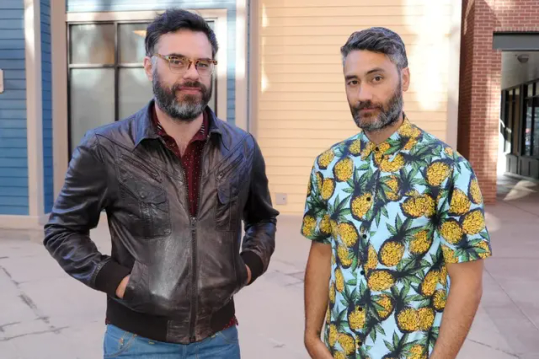
With Jemaine Clement in 2014. (Getty Images)
But they eventually bonded over Blackadder and Fawlty Towers, and especially Kenny Everett, and did comedy shows together everywhere from Edinburgh to Melbourne. Waititi was almost itinerant, spending months at a time busking, or living in a commune in Berlin. He acted in a few small films, and then – while playing a stripper on a bad TV show – realised he wanted to try life behind the camera. “I became tired of being told what to do and ordered around,” he told Wellington’s Dominion Post in 2004. “I remember sitting around in the green room in my G-string thinking, ‘Why am I doing this? Just helping someone else to realise their dream.’ ”
He did two strong short films, then directed his first feature – Eagle vs Shark (2007) – when he was 32. He brought his mates along (Clement, starring with Waititi’s then-girlfriend Loren Horsley), setting something of a pattern in his career: hiring friends instead of constantly navigating new working relationships. “If you look at things I’m doing,” he tells me, “there’s always a few common denominators.”
Sam Neill says Waititi is the exemplar of a new New Zealand humour. “The basis of it is this: we’re just a little bit crap at things.”
This gang of collaborators shares a common Kiwi vibe, too, which his longtime friend, actor Rhys Darby, once coined “the comedy of the mundane”. Their new TV show, Our Flag Means Death, for example, leans heavily into the mundanity of pirate life – what happens on those long days at sea when the crew aren’t unsheathing swords from scabbards or burying treasure.
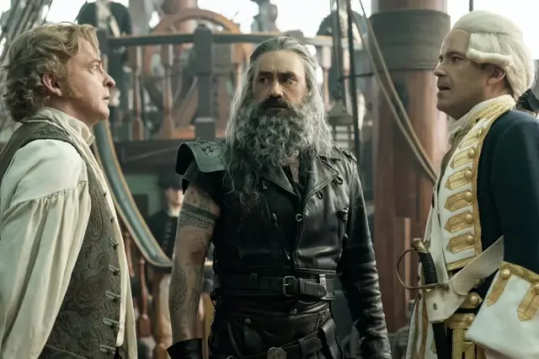
Waititi plays pirate captain Blackbeard, centre, in Our Flag Means Death, with Rhys Darby, left, and Rory Kinnear. (Google Images)
Sam Neill, who first met Waititi when starring in Hunt for the Wilderpeople, says Waititi is the exemplar of a new New Zealand humour. “And I think the basis of it is this,” says Neill. “We’re just a little bit crap at things, and that in itself is funny.” After all, Neill asks, what is What We Do in The Shadows (2014) if not a film (then later a TV show) about a bunch of vampires who are pretty crap at being vampires, living in a pretty crappy house, not quite getting busted by crappy local cops? “New Zealand often gets named as the least corrupt country in the world, and I think it’s just that we would be pretty crap at being corrupt,” Neill says. “We don’t have the capacity for it.”
Waititi’s whimsy also spurns the dominant on-screen oeuvre of his homeland – the so-called “cinema of unease” exemplified by the brutality of Once Were Warriors (1994) and the emotional peril of The Piano (1993). Waititi still explores pathos and pain, but through laughter and weirdness. “Taika feels to me like an antidote to that dark aspect, and a gift somehow,” Neill says. “And I’m grateful for that.”
-----------------------------------------------
Something happened to Taika Waititi when he was about 11 – something he doesn’t go into with Good Weekend, but which he considered a betrayal by the adults in his life. He mentioned it only recently – not the moment itself, but the lesson he learnt: “That you cannot and must not rely on grown-ups to help you – you’re basically in the world alone, and you’re gonna die alone, and you’ve just gotta make it all for yourself,” he told Irish podcast host James Brown. “I basically never forgave people in positions of responsibility.”
What does that mean in his work? First, his finest films tend to reflect the clarity of mind possessed by children, and the unseen worlds they create – fantasies conjured up as a way to understand or overcome. (His mum once summed up the main message of Boy: “The unconditional love you get from your children, and how many of us waste that, and don’t know what we’ve got.”)
Second, he’s suited to movie-making – “Russian roulette with art” – because he’s drawn to disruptive force and chaos. And that in turn produces creative defiance: allowing him to reinvigorate the Marvel Universe by making superheroes fallible, or tell a Holocaust story by making fun of Hitler. “Whenever I have to deal with someone who’s a boss, or in charge, I challenge them,” he told Brown, “and I really do take whatever they say with a pinch of salt.”
It’s no surprise then that Waititi was comfortable leaping from independent films to the vast complexity of Hollywood blockbusters. He loves the challenge of coordinating a thousand interlocking parts, requiring an army of experts in vocations as diverse as construction, sound, art, performance and logistics. “I delegate a lot,” he says, “and share the load with a lot of people.”
“This is a cool concept, being able to afford whatever I want, as opposed to sleeping on couches until I was 35.” - Taika Waititi
But the buck stops with him. Time magazine named Waititi one of its Most Influential 100 People of 2022. “You can tell that a film was made by Taika Waititi the same way you can tell a piece was painted by Picasso,” wrote Sacha Baron Cohen. Compassionate but comic. Satirical but watchable. Rockstar but auteur. “Actually, sorry, but this guy’s really starting to piss me off,” Cohen concluded. “Can someone else write this piece?”
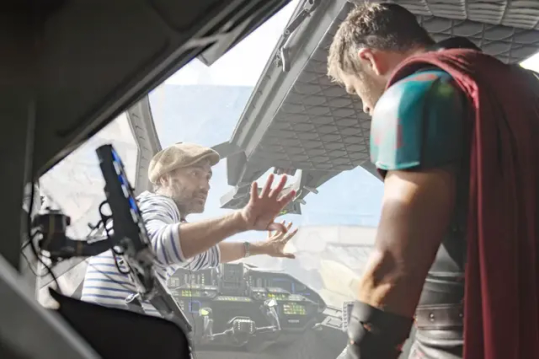
Directing Chris Hemsworth in 2017 in Thor: Ragnarok, which grossed more than $1.3 billion at the box office. (Alamy)
I’m curious to know how he stays grounded amid such adulation. Coming into the game late, he says, helped immensely. After all, Waititi was 40 by the time he left New Zealand to do Thor: Ragnarok. “If you let things go to your head, then it means you’ve struggled to find out who you are,” he says. “But I’ve always felt very comfortable with who I am.” Hollywood access and acclaim – and the pay cheques – don’t erase memories of poverty, either. “It’s more like, ‘Oh, this is a cool concept, being able to afford whatever I want, as opposed to sleeping on couches until I was 35.’ ” Small towns and strong tribes keep him in check, too. “You know you can’t piss around and be a fool, because you’re going to embarrass your family,” he says. “Hasn’t stopped me, though.”
Sam Neill says there was never any doubt Waititi would be able to steer a major movie with energy and imagination. “It’s no accident that the whole world wants Taika,” he says. “But his seductiveness comes with its own dangers. You can spread yourself a bit thin. The temptation will be to do more, more, more. That’ll be interesting to watch.”
Indeed, I find myself vicariously stressed out over the list of potential projects in Waititi’s future. A Roald Dahl animated series for Netflix. An Apple TV show based on the 1981 film Time Bandits. A sequel to What We Do In The Shadows. A reboot of Flash Gordon. A gonzo horror comedy, The Auteur, starring Jude Law. Adapting a cult graphic novel, The Incal, as a feature. A streaming series based on the novel Interior Chinatown. A film based on a Kazuo Ishiguro bestseller. Plus bringing to life the wildly popular Akira comic books. Oh, and for good measure, a new instalment of Star Wars, which he’s already warned the world will be … different.
“It’s going to change things,” he told Good Morning America. “It’s going to change what you guys know and expect.”
Did I say I was stressed for Waititi? I meant physically sick.
“Well…” he qualifies, “some of those things I’m just producing, so I come up with an idea or someone comes to me with an idea, and I shape how ‘it’s this kind of show’ and ‘here’s how we can get it made.’ It’s easier for me to have a part in those things and feel like I’ve had a meaningful role in the creative process, but also not having to do what I’ve always done, which is trying to control everything.”
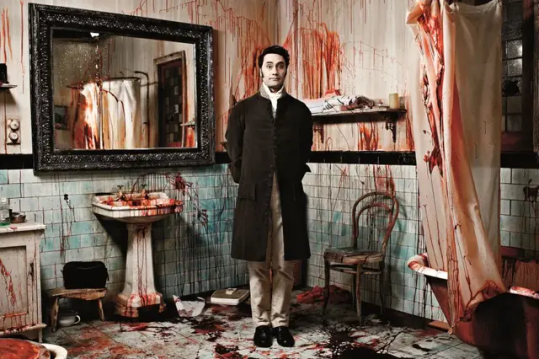
In the 2014 mockumentary horror film What We Do in the Shadows, which he co-directed with Jemaine Clement. (Alamy)
What about moving away from the niche New Zealand settings he represented so well in his early work? How does he stay connected to his roots? “I think you just need to know where you’re from,” he says, “and just don’t forget that.”
They certainly haven’t forgotten him.
Jasmin McSweeney sits in her office at the New Zealand Film Commission in Wellington, surrounded by promotional posters Waititi signed for her two decades ago, when she was tasked with promoting his nascent talent. Now the organisation’s marketing chief, she talks to me after visiting the heart of thriving “Wellywood”, overseeing the traditional karakia prayer on the set of a new movie starring Geoffrey Rush.
Waititi isn’t the first great Kiwi filmmaker – dual Oscar-winner Jane Campion and blockbuster king Peter Jackson come to mind – yet his particular ascendance, she says, has spurred unparalleled enthusiasm. “Taika gave everyone here confidence. He always says, ‘Don’t sit around waiting for people to say, you can do this.’ Just do it, because he just did it. That’s the Taika effect.”
-----------------------------------------------
Taika David Waititi is known for wearing everything from technicolour dreamcoats to pineapple print rompers, and today he’s wearing a roomy teal and white Isabel Marant jumper. The mohair garment has the same wispy frizz as his hair, which curls like a wave of grey steel wool, and connects with a shorn salty beard.
A stylish silver fox, it wouldn’t surprise anyone if he suddenly announced he was launching a fashion label. He’s definitely a commercial animal, to the point of directing television commercials for Coke and Amazon, along with a fabulous 2023 spot for Belvedere vodka starring Daniel Craig. He also joined forces with a beverage company in Finland (where “taika” means “magic”) to release his coffee drinks. Announcing the partnership on social media, he flagged that he would be doing more of this kind of stuff, too (“Soz not soz”).
Waititi has long been sick of reverent portrayals of Indigenous people talking to spirits.
There’s substance behind the swank. Fashion is a creative outlet but he’s also bought sewing machines in the past with the intention of designing and making clothes, and comes from a family of tailors. “I learnt how to sew a button on when I was very young,” he says. “I learnt how to fix holes or patches in your clothes, and darn things.”
And while he gallivants around the globe watching Wimbledon or modelling for Hermès at New York Fashion Week, all that glamour belies a depth of purpose, particularly when it comes to Indigenous representation.
There’s a moment in his new movie where a Samoan player realises that their Dutch coach, played by Michael Fassbender, is emotionally struggling, and he offers a lament for white people: “They need us.” I can’t help but think Waititi meant something more by that line – maybe that First Nations people have wisdom to offer if others will just listen?
“Weeelllll, a little bit …” he says – but from his intonation, and what he says next, I’m dead wrong. Waititi has long been sick of reverent portrayals of Indigenous people talking to kehua (spirits), or riding a ghost waka (phantom canoe), or playing a flute on a mountain. “Always the boring characters,” he says. “They’ve got no real contemporary relationship with the world, because they’re always living in the past in their spiritual ways.”

A scene from Next Goal Wins, filmed earlier this year. (Alamy)
He’s part of a vanguard consciously poking fun at those stereotypes. Another is the Navajo writer and director Billy Luther, who met Waititi at Sundance Film Festival back in 2003, along with Reservation Dogs co-creator Sterlin Harjo. “We were this group of outsiders trying to make films, when nobody was really biting,” says Luther. “It was a different time. The really cool thing about it now is we’re all working. We persevered. We didn’t give up. We slept on each other’s couches and hung out. It’s like family.”
Waititi has power now, and is known for using Indigenous interns wherever possible (“because there weren’t those opportunities when I was growing up”), making important introductions, offering feedback on scripts, and lending his name to projects through executive producer credits, too, which he did for Luther’s new feature film, Frybread Face and Me (2023).
He called Luther back from the set of Thor: Love and Thunder (2022) to offer advice on working with child actors – “Don’t box them into the characters you’ve created,” he said, “let them naturally figure it out on their own” – but it’s definitely harder to get Waititi on the phone these days. “He’s a little bitch,” Luther says, laughing. “Nah, there’s nothing like him. He’s a genius. You just knew he was going to be something. I just knew it. He’s my brother.“
I’ve been asked to explicitly avoid political questions in this interview, probably because Waititi tends to back so many causes, from child poverty and teenage suicide to a campaign protesting offshore gas and oil exploration near his tribal lands. But it’s hard to ignore his recent Instagram post, sharing a viral video about the Voice to Parliament referendum starring Indigenous Aussie rapper Adam Briggs. After all, we speak only two days after the proposal is defeated. “Yeah, sad to say but, Australia, you really shat the bed on that one,” Waititi says, pausing. “But go see my movie!”
About that movie – the early reviews aren’t great. IndieWire called it a misfire, too wrapped in its quirks to develop its arcs, with Waititi’s directorial voice drowning out his characters, while The Guardian called it “a shoddily made and strikingly unfunny attempt to tell an interesting story in an uninteresting way”. I want to know how he moves past that kind of criticism. “For a start, I never read reviews,” he says, concerned only with the opinion of people who paid for admission, never professional appraisals. “It’s not important to me. I know I’m good at what I do.”
Criticism that Indigenous concepts weren’t sufficiently explained in Next Goal Wins gets his back up a little, though. The film’s protagonist, Jaiyah Saelua, the first transgender football player in a FIFA World Cup qualifying match, is fa’afafine – an American Samoan identifier for someone with fluid genders – but there wasn’t much exposition of this concept in the film. “That’s not my job,” Waititi says. “It’s not a movie where I have to explain every facet of Samoan culture to an audience. Our job is to retain our culture, and present a story that’s inherently Polynesian, and if you don’t like it, you can go and watch any number of those other movies out there, 99 per cent of which are terrible.”
*notes: (there is video clip in the article)
Waititi sounds momentarily cranky, but he’s mostly unflappable and hilarious. He’s the kind of guy who prefers “Correctumundo bro!” to “Yes”. When our video connection is too laggy, he plays up to it by periodically pretending to be frozen, sitting perfectly still, mouth open, his big shifting eyeballs the only giveaway.
He’s at his best on set. Saelua sat next to him in Honolulu while filming the joyous soccer sequences. “He’s so chill. He just let the actors do their thing, giving them creative freedom, barely interjecting unless it was something important. His style matches the vibe of the Pacific people. We’re a very funny people. We like to laugh. He just fit perfectly.”
People do seem to love working alongside him, citing his ability to make productions fresh and unpredictable and funny. Chris Hemsworth once said that Waititi’s favourite gag is to “forget” that his microphone is switched on, so he can go on a pantomime rant for all to hear – usually about his disastrous Australian lead actor – only to “remember” that he’s wired and the whole crew is listening.
“I wouldn’t know about that, because I don’t listen to what other people say about anything – I’ve told you this,” Waititi says. “I just try to have fun when there’s time to have fun. And when you do that, and you bring people together, they’re more willing to go the extra mile for you, and they’re more willing to believe in the thing that you’re trying to do.”
Yes, he plays music between takes, and dances out of his director’s chair, but it’s really all about relaxing amid the immense pressure and intense privilege of making movies. “Do you know how hard it is just to get anything financed or green-lit, then getting a crew, getting producers to put all the pieces together, and then making it to set?” Waititi asks. “It’s a real gift, even to be working, and I feel like I have to remind people of that: enjoy this moment.”
Source: The Age
By: Konrad Marshall (December 1, 2023)
198 notes
·
View notes
Text
Sometimes I think about
Misha telling the story of how, at the start of SPN s4 or 5, he went to Robert Singer and asked if Singer had any ideas about where he should take his character, and Singer looked at him with utter contempt and said, "You're not gonna be one of those actors, are you?"
And now, at Gotham Knights...
Misha: Maybe Harvey could change clothes now and then?
Jennifer May Nickel: Sure--let's go with two to four custom-fitted suits per episode, all with some subtle detailing playing on the number two or calling back to an iconic Two-Face story.
Misha: You know I have a motorcycle license...wouldn't it be cool...?
TPTB: Next ep, you're riding a motorcycle!
Misha: You would not believe this crazy dream I had about Harvey...
TPTB: Brilliant! Let's put it in the show!
Why am I so pleased that this middle-aged total stranger is finally being valued at his workplace?
#misha collins#gotham knights#gk cw#harvey dent#some minor spoilers i guess#they really are giving that man everything he asks for#GOOD#op
641 notes
·
View notes
Text



Recently watched: The Unholy Wife (1957). Tagline: “Half-angel. Half-devil. She made him half-a-man!” This pedestrian but enjoyably sordid film noir is unique for being made in scorching colour. Even in the faded print circulating on YouTube, British leading lady Diana Dors’ gleaming platinum hair and skin-tight costumes in royal blue, fuchsia and ice pink are eye-popping. (Director John Farrow was no hack: he made some of Robert Mitchum’s greatest films (Where Danger Lives (1950), His Kind of Woman (1951). He clearly had an “off day” here). The Unholy Wife offers a portrait of a dysfunctional marriage in the verdant sun-dappled vineyards of Napa Valley. Or as the publicity blurb promises “This is the wine cellar of the most respectable house in the Valley. This is where she met them, made love to them, laughed with them at her husband … at the man who gave her a name, a home and a heritage – the man she wanted to destroy!” The action unfolds in flashback, with present-day Phyllis (whose name evokes the Barbara Stanwyck character Phyllis Dietrichson in Double Indemnity (1944)) in jail, recounting the events that led to her imprisonment. In a role originally intended for Shelley Winters, Dors is a seething, manipulative married woman scheming with her lantern-jawed, broad-shouldered lover San (hunky Tom Tryon) to murder her cuckolded husband, vineyard owner Paul (played by Rod Steiger – in a role originally intended for Ernest Borgnine - in the then-fashionable mumbling Actor’s Studio tradition). Wringing her hands in the background is mother-in-law Emma, played by Beulah Bondi (a part intended for Ethel Barrymore). Watch for one truly glorious sequence of Phyllis and her pal Gwen (hardboiled, nicotine-saturated noir icon Marie Windsor) toiling as “hostesses” at a low-down gin joint. While the blowzy resident nightclub singer (Maxine Gates) wails “One for My Baby (and One More for the Road”), Phyllis – sheathed in sensational silver lamé - kvetches, “Not much action around here tonight.” The commercial and critical failure of The Unholy Wife ultimately cut short Dors’ brief and unhappy sojourn in Hollywood, and she returned to the United Kingdom. (Dors and Steiger also had a fling during production).
#the unholy wife#diana dors#marie windsor#lobotomy room#film noir#vintage sleaze#bad movies for bad people#bad movies we love#platinum blonde#bad girl#1950s hollywood
23 notes
·
View notes
Text









nicola roberts like/reblog 🌟
#nicola roberts#nicola roberts icons#icons nicola roberts#british#singer#girls aloud#girls aloud icons#redhead icons#icons#girls icons#twitter icons#female icons#without psd#ginger icons
13 notes
·
View notes
Text

Figaro's Famous Fanfare | 66 Brilliant Baritones Battle OUT NOW!
Gioachino Rossini’s opera Il Barbiere di Siviglia (The Barber of Seville) remains one of the most beloved and enduring works in the operatic repertoire.
Among its many memorable moments, Figaro's entrance aria, "Largo al Factotum," stands out as a tour de force for the baritone voice and a cornerstone for both character development and comedic expression.
The famous "Figaro, Figaro, Figaro" section, performed unaccompanied, exemplifies Rossini's wit, musical humour, and masterful control of operatic timing.
This moment showcases the singer’s vocal precision, agility, and musicianship, while also highlighting their acting skills, characterisation, dramatic flair, and ability to engage the audience.
In this 10-minute video, 66 great operatic baritones bring their own unique interpretations to this iconic a cappella passage.
List of Figaros:
Giuseppe Campanari [1855–1927] — Over 200 Met performances Mattia Battistini [1856–1928] — ‘King of Baritones’ Joseph Winogradoff [1866–1936] — Sang Figaro in Yiddish John Forsell [1868–1941] — Debuted as Figaro Mario Sammarco [1868–1930] — Noted for versatility & acting Emilio De Gogorza [1872–1949] — Recorded prodigiously
Riccardo Stracciari [1875–1955] — Figaro a signature role Giuseppe De Luca [1876–1950] — Created Sharpless & Schicchi Titta Ruffo [1877–1953] — ‘Voice of The Lion’ Pasquale Amato [1878–1942] — Sang at the Met 1908–1921 Peter Dawson* [1882–1961] — Bass-baritone. Over 1500 recordings Carlo Galeffi [1882–1961] — One of the finest interwar baritones
Enrico Molinari [1882–1956] — Sang as bass & baritone Armand Crabbé [1883–1947] — A lead in London 1906–1914, 1937 Giuseppe Danise [1883–1963] — Four Met premieres Anafesto Rossi [1883–1933] — Graduated as a bass Enrico De Franceschi [1885–1945] — Figaro in Turin & Honduras Umberto Urbano [1885–1969] — Recorded ‘marvels of lyric beauty’
Apollo Granforte [1886–1975] — c.1800 performances Giulio Fregosi [1887–1951] — Figaro in Paris Luigi Montesanto [1887–1954] — Created Michele Giacomo Rimini [1887–1952] — Sang Figaro with GalliCurci Heinrich Schlusnus [1888–1952] —Top German interwar lyric baritone Mariano Stabile [1888–1968] — Outstanding singing-actor
Richard Bonelli [1889–1980] — Sang Figaro in early sound film Benvenuto Franci [1891–1985] — A top Figaro interpretator John Charles Thomas [1891–1960] — Hollywood Walk of Fame Mario Basiola [1892–1965] — 66 roles. Taught by Cotogni Giovanni Inghilleri [1894–1959] — Sang with Ponselle & Gigli Lawrence Tibbett [1896–1960] — Legendary singer & actor
Iso Golland [1898–1961] — Respected pedagogue Dennis Noble* [1898–1966] — Bristolian [UK]. Prolific broadcaster Carlo Tagliabue [1898–1978] — Sang Wagner, Excelled at Verdi Ivan Petroff [1899–1963] — Debuted as Figaro Igor Gorin [1904–1982] — Cantor fluent in 8 languages Alexander Sved [1906–1979] — Taught by Sammarco & Stracciari
Frank Valentino [1907–1991] — 26 roles in 21 seasons at the Met Leonard Warren [1911–1960] — Met lead. Had a top C Gino Bechi [1913–1993] — Cast in musical films Tito Gobbi [1913–1984] — 136 roles over 44 years Paolo Silveri [1913–2001] — Sang as bass, baritone & tenor Giuseppe Valdengo [1914–2007] — Debuted as Figaro
Josef Metternich [1915–2005] — Created Hindemith’s Kepler Giuseppe Taddei [1916–2010] — Aged 69 at Met debut Robert Merrill [1917–2004] — Met’s principal baritone Manuel Ausensi [1919–2005] — Famous full recording of this opera Sesto Bruscantini [1919–2003] — Also sang Bartolo Aldo Protti [1920–1995] — Student of Basiola
Ettore Bastianini [1922–1967] — Recorded this opera for Decca Cornell MacNeil [1922–2011] — ‘Rivals, but [..] no equals’ Renato Capecchi [1923–1998] — Singer, actor & director Frank Guarrera [1923–2007] — Figaro a signature role Rolando Panerai [1924–2019] — More than 150 roles. Famed for buffo Piero Cappuccilli [1926–2005] — 17 major Verdi roles
Nicolae Herlea [1927–2014] — Sang Figaro c.550 times Peter Glossop [1928–2008] — A lead in London, Europe & USA Hermann Prey [1929–1998] — Figaro in film and live TV Yuri Gulyayev [1930–1986] — Figaro a best role Yuri Mazurok [1931–2006] — People’s Artist of the USSR Stoyan Popov [1933–2017] — ’The Bulgarian Titto Gobbi’
Sherrill Milnes [1935-] — Recorded Figaro under Levine Franco Pagliazzi [1937–2018] — Became dramatic tenor Silvano Carroli [1939–2020] — Taught by Mario Del Monaco Muslim Magomayev [1942–2008] — ’Soviet Sinatra’ Allan Monk [1942-] — Awarded a Golden Jubilee Medal Amartuvshin Enkhbat [1986-] — Numerous international awards
*Recorded 'Largo al Factotum' in the Key of Bb

Please join me for the premiere of this new video and share your thoughts in the comments and in the chat! I’m curious… Who’s YOUR favourite Figaro?! 🎶
There's a 'notify me' option available on the video page
Feel free to invite anyone else who might enjoy it— I look forward to you joining me there! Moodoo Van Spoon
youtube
11 notes
·
View notes
Text
That was one heck of a show, Beyonce the woman you are...
If you haven’t seen it already, Beyonce’s incredible halftime performance at an NFL game on Christmas Day has outstanding imagery and deep cultural significance towards African American history.

In no particular order, I will break down this performance of her album Cowboy Carter.
We see Beyonce riding in on a white horse. White horses symbolize American spirit, “a relentless pursuit of freedom and justice” and in greek mythology, finding and riding a white horse grants great power and success.

With the backlash of her album Cowboy Carter, she is stating that she can find success in any genre as she is already widely successful in hers. It’s also just the cowgirl thing to do.
Beyonce is also from Houston, Texas, a place known for being very southern and having deep country roots as well as her mother being from Louisiana, and it doesn’t get any more country than that!
Many of her dancers and performers in the show were seen wearing white bandanas. White bandanas signify unity, which Beyonce is trying to do with her crossing over genres.
The band playing was TSU’s “Ocean of Soul,” which is an HBCU, or historically black college and university marching band.

The women singing “Blackbird” beside Beyonce in the opening were Tanner Adell, Tiera Kennedy, Reyna Roberts, and Brittney Spencer, all black women country singers. The song “Blackbird” originally sung by The Beatles is a song inspired as a message of hope to Black women during the Civil Rights movement.

Shaboozey performed his song with Beyonce “Sweet Honey Buckin”, as he is also an up-and-coming black country artist.

She had various young black talent portrayed all throughout her show along with Ja'Dayia Kursh who became Arkansas' first Black rodeo queen in 2017.

In the scenes where carriages and Cadillac cars were in shot, they were decorated with roses. During Juneteenth celebrations in Texas in the early 1900s, their buggies, carts, and wagons were often decorated with roses. Juneteenth, or June 19, 1865, is a day marked and celebrated to be the end of African American slavery in America.


In a scene you can see performers standing on top of the horses, this signifies a popular, powerful photograph from a 2009 article by Gabriela Hasbun for Andscape, where six black men are seen standing on their horses. A tribute to black cowboys in America.


After Beyonce’s iconic release of her album Lemonade, she performed “Daddy Lessons”, a country-leaning song, at the 2016 Country Music Awards alongside Dixie Chicks and the backlash was brutal. Country fans and C.M.A. watchers did not like the fact that Beyonce was there since she was not a country artist, and they also criticized her political views at the time.
Following the blatant discrimination and backlash, the Country Music Association in Nashville took down every trace of the live performance off of their platforms and photos taken by them. They did not defend Beyonce and people did not take lightly to that.
After Cowboy Carter's release in early 2024, the C.M.A. disrespected Beyonce again as they did not recognize Beyonce and Cowboy Carter and she did not receive one nominee for this album despite its high praise and topping the country music charts.
This halftime show performance and Cowboy Carter in general is a beautiful articulation of being black in a predominately white business, (and country). She took something that is supposedly only for white Americans and made it a cultural phenomenon in music and black music history.
“The cowboy is a symbol of strength and aspiration in America. The cowboy was named after slaves who handled the cows. The word ‘cowboy’ comes from those who were called boys, never given the respect they deserved,” - Beyonce
7 notes
·
View notes
Text
Top 10 Hollywood Romcoms of the 90s
The 90s was a golden era for romantic comedies in Hollywood. From iconic pairings to unforgettable storylines, there were so many romantic comedies that captured our hearts and made us laugh. In this blog post, we will take a trip down memory lane and revisit the top 10 Hollywood romcoms of the 90s.
1. Pretty Woman (1990)
Pretty Woman is a classic romantic comedy that tells the story of a wealthy businessman who falls in love with a prostitute he hires to be his escort for a week. Starring Julia Roberts and Richard Gere, this movie has become a staple in the romcom genre and is beloved by audiences around the world.
2. When Harry Met Sally (1989)
While technically released in the late 80s, When Harry Met Sally is a quintessential 90s romantic comedy. It follows the relationship between Harry and Sally over the course of several years, exploring the question of whether men and women can truly be friends. Starring Meg Ryan and Billy Crystal, this movie has become an iconic part of romantic comedy history.
3. Sleepless in Seattle (1993)
Sleepless in Seattle is a heartwarming romantic comedy that tells the story of a widower who, with the help of his young son, tries to find love again. Starring Tom Hanks and Meg Ryan, this movie is a classic example of the power of love to heal even the most broken hearts.
4. Four Weddings and a Funeral (1994)
Four Weddings and a Funeral follows the story of a group of friends and their romantic entanglements over the course of several weddings and a funeral. Starring Hugh Grant and Andie MacDowell, this movie is a charming and witty look at love and relationships.
5. The Wedding Singer (1998)
The Wedding Singer is a hilarious romantic comedy that takes place in the 80s and follows the story of a wedding singer who falls in love with a waitress. Starring Adam Sandler and Drew Barrymore, this movie is filled with nostalgia, great music, and a heartwarming love story.
6. You've Got Mail (1998)
You've Got Mail is a delightful romantic comedy that tells the story of two business rivals who fall in love with each other online without realizing they are actually enemies in real life. Starring Tom Hanks and Meg Ryan, this movie is a modern take on the classic love story.
7. My Best Friend's Wedding (1997)
My Best Friend's Wedding is a romantic comedy about a woman who realizes she is in love with her best friend just as he is about to get married. Starring Julia Roberts, Dermot Mulroney, and Cameron Diaz, this movie is a funny and heartwarming exploration of love and friendship.
8. Clueless (1995)
Clueless is a beloved romantic comedy that follows the life of a popular high school student who decides to play matchmaker for her friends while also navigating her own romantic relationships. Starring Alicia Silverstone, this movie has become a cult classic and a defining film of the 90s.
9. Notting Hill (1999)
Notting Hill is a romantic comedy about a bookstore owner who falls in love with a famous actress. Starring Julia Roberts and Hugh Grant, this movie is a charming and romantic story about two people from very different worlds finding love.
10. The American President (1995)
The American President is a romantic comedy that tells the story of a widowed president who falls in love with a lobbyist. Starring Michael Douglas and Annette Bening, this movie is a smart and funny exploration of love in the political world.
The 90s was a decade filled with romantic comedies that continue to be beloved by audiences today. From Pretty Woman to The American President, these movies captured our hearts and made us believe in the power of love. Whether you're in the mood for a classic love story or a hilarious take on modern romance, these 10 movies are sure to deliver.
#anxitey#college#university#student life#university student#rom com#90s movies#pretty woman#when harry met sally#sleepless in seattle#four weddings and a funeral#the wedding singer#youve got mail#my bestfriend's wedding#clueless#notting hill#the american president#hollywood#90s hollywoodl#julia roberts#tom hanks#drew barrymore#alicia silverstone#cameron diaz#viralpost#viral#fyp
117 notes
·
View notes